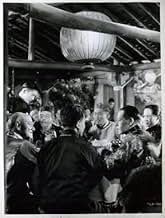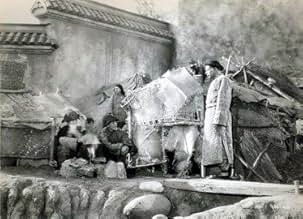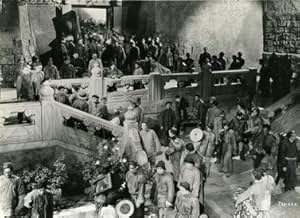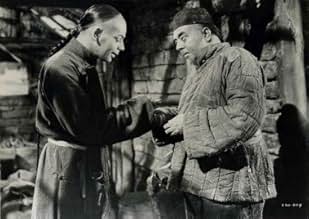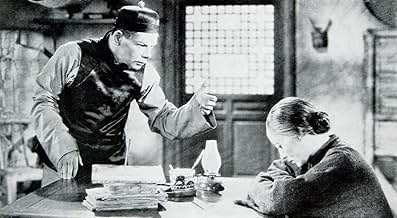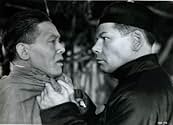Obwohl die verheirateten chinesischen Bauern Wang und O-Lan zunächst Erfolg haben, wird ihr Leben durch sinkendes Vermögen und magere Zeiten kompliziert.Obwohl die verheirateten chinesischen Bauern Wang und O-Lan zunächst Erfolg haben, wird ihr Leben durch sinkendes Vermögen und magere Zeiten kompliziert.Obwohl die verheirateten chinesischen Bauern Wang und O-Lan zunächst Erfolg haben, wird ihr Leben durch sinkendes Vermögen und magere Zeiten kompliziert.
- 2 Oscars gewonnen
- 7 Gewinne & 3 Nominierungen insgesamt
- Revolutionary Army Captain
- (Nicht genannt)
- Man
- (Nicht genannt)
- Teahouse Dancer
- (Nicht genannt)
- Chinese Girl
- (Nicht genannt)
Empfohlene Bewertungen
It was soap-operish at times but had some visually dramatic moments, too, capped off by a locust attack at the end of the film. That was astounding to view. Considering this film is about 70 years old, the special-effects crew on this film did a spectacular job.
Paul Muni and Luise Rainer were award-winning actors in their day and they don't disappoint here, both giving powerful performances. The only problem is credibility as all the Asians are played by Caucasions and some of them, like Walter Connolly, just don't look real. I'd like to see a re-make of this movie with all-Asian actors, not for PC reasons but to simply make the story look and sound more credible.
This is a truly great epic story of love, individual rights, class strata, and men/women issues. The centerpiece of the film is two brilliant performances by Luise Rainer and Paul Muni.
Muni plays Wang, a Chinese farmer, who is about to take a wife (Rainer). From the start, he treats her with respect, during a time when women were looked on as little more than hired help. Without giving too much of the movie away, they go through the highs and lows of all relationships, and even though the story may take place in late 19th/early 20th century,the story and much of their feelings, seems credible.
Other than the fact that the movie is about 5-10 minutes longer than it needs to be, and the performances of Charley Grapewin and Walter Connolly are typical 1930's cartoon characters, this is a really wonderful movie that, unfortunately, has become a victim of political correctness.
9 out of 10
I was particularly impressed by the camera work and the use of crowd scenes, especially during the sacking of the palace where O-Lan was once a slave. The graphic and grim atmosphere of the firing squad and the drought made this an epic quite unlike others of the same time where it was all glitz and glitter. I watched this film from beginning to end enthralled. I can't say the same for the "epics" of today.
For those people who thought "The Good Earth" was dull and not entertaining, I have nothing to say. They are entitled to their opinion, but they missed one of life's most important lesson's: Humility and loyalty.
I was fortunate to see this film when it was FIRST released - in 1939. It's wonderful story (Pearl S. Buck) written for film (Talbot Jennings) has stayed with me all through my long life. I saw it in a theater then; I found it in the "garbage bin" in Wal-Mart this year (2011) and bought it immediately....I had it in a huge collection I gave to a library in Los Angeles when I moved to Florida. The copy I have now was made from the original cut - there are black screens between big scenes. I don't remember that after all these years, but accept it was the way the early release looked. It doesn't bother me - it gives me more time to think of what I have just viewed and anxious to see what's next. To me, the story is so engrossing the length of the film doesn't even occur to me - I would have liked the ending to be longer, because "Olan, you are the earth" told the entire reason for the story of true love and devotion, to the extreme.....
I'm not even bothered by the question so many people asked of why Paul Muni ("Wang Lung") and Luise Rainer ("Olan") were cast instead-of Asians - I had never seen Ms. Rainer in any film, and have no idea why her Hollywood career faded. She was considered to be a great beauty. Paul Muni I've seen in other films, but he wasn't one of my favorites. Yes, I have always wondered how "Gone with the Wind" - beat it out of an award: actually, I thought "The Good Earth" was filmed in color. Now, I'm not even concerned about that - the STORY, the ultimate entirety of the film's huge scenes and huge cast dismisses any negative comment I could think of, or read.
Walter Connolly ("Uncle") and Charlie Grapewin ("Old Father") were perfectly cast and played their roles with great skill. All of the cast were consummate in their roles; director Sidney Franklin held a strong grip of the totality of the film and got it all right. As time progressed into a more modern era, the characters became more modern: except, "Olan" stayed the wonderful woman she was.
However - Ms. Rainer stole the entire movie. A good actress does not always need words to say. I feel the story of a peasant-farmer and his ex-slave wife, all of the troubles they encountered (and defeated), the entire cast presented an accurate portrayal of the story in those days - China. It is hard for me to visualize any re-make could be better, and feel any CGIs would be completely unnecessary. It is also hard for me to realize China's last emperor was alive when I went to Hawai'i in 1969......living a peasant-life, just as did "Wang Lung" and "Olan".
Anyone who views "The Good Earth" and doesn't readily understand that life is bigger than any of us, haven't really lived. It gets a 20 from me - I recommend it to every living soul.
The story begins on the wedding day of Wang Lung (Paul Muni), a kind and gentle farmer. His wife, O-Lan (Luise Rainer), bears his sons and quietly encourages him to pursue his dreams, no matter what sacrifices they entail from her. The family lives through a famine and finally achieves prosperity and success. However, with success comes greed and corruption, and soon Wang is buying large plots of land and the Great Hall at which O-Lan was a servant. Eventually, he takes a second wife and breaks ties with all who were once close to him. It takes a tragedy for him to see the error of his ways.
All the while O-Lan stands behind him, supporting every decision he makes in her own tranquil way. Rainer's Oscar winning portrayal, like O-Lan herself, is the glue that holds the story together. Muni, often prone to hamminess in his work, shows restraint here and contributes a beautiful, multifaceted performance. The cinematography, which also received an Oscar, is excellent, as are the special effects. A sequence which involves locusts, invading the crops by the million, is nothing short of unforgettable. It is storytelling in the grandest sense of the word, with strong characterizations, high production values, and an engrossing story which more than justifies `The Good Earth's status as a classic.
Wusstest du schon
- WissenswertesSpecial effects experts were unable to produce an authentic-looking locust plague. Just as they were about to abandon the scene, they received word that a real locust plague was taking place several states away. A camera crew was rushed to the scene to capture it on film.
- Patzer(at around 2h 5 mins) Wang Lung is walking through the locust storm in his wheat field. He picks up a few men who have fallen down into the thick pile of locusts. In frustration, Wang shouts "I said save the wheat! Save it!" At this moment, a man dressed in 1937-era American clothing walks across the scene from left to right, at the top third of the screen. He is wearing a white hat and appears to be smoking a cigarette or cigar held in his left hand.
- Zitate
Wang Lung: [must sell his land to feed his family but the buyers take advantage of him] Thieves! Thieves! And well you know I must sell.
O-Lan: No! Not the land. We'll not sell the land. We'll keep it. We'll go south and when we return, we'll still have the land.
Uncle: But I've arranged it. I brought these men here. You MUST sell!
O-Lan: Is it your land? Did you buy it bit by bit? The land is our life... and it's better to go south... or die walking... than to give it to you for nothing.
- Crazy CreditsIntroduction played with opening credits: The soul of great nation is expressed in the life of its humblest people. In this simple story of a Chinese farmer may be found something of a the soul of China - its humility, its courage, its deep heritage from the past and its vast promise for the future.
- VerbindungenEdited into Dragon Seed (1944)
Top-Auswahl
Details
- Erscheinungsdatum
- Herkunftsland
- Offizieller Standort
- Sprache
- Auch bekannt als
- The Good Earth
- Drehorte
- Cedar City, Utah, USA(backgrounds for locust sequence)
- Produktionsfirma
- Weitere beteiligte Unternehmen bei IMDbPro anzeigen
Box Office
- Budget
- 2.800.000 $ (geschätzt)
- Laufzeit
- 2 Std. 18 Min.(138 min)
- Seitenverhältnis
- 1.37 : 1



